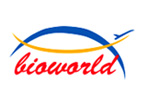Product Name :
CD47 Recombinant Protein Swiss-Prot :
Q08722 Host :
E.coli Tag :
≥0.5mg/ml Amino acid Sequence :
QLLFNKTKSVEFTFCNDTVVIPCFVTNMEAQNTTEVYVKWKFKGRDIYTFDGALNKSTVPTDFSSAKIEVSQLLKGDASLKMDKSDAVSHTGNYTCEVTELTREGETIIELKYRVVSWFSPNE Restriction sites :
NdeI-XhoI Background :
CD47 is a five-pass transmembrane protein expressed on all normal cells. It binds to the SIRPa that is expressed on myeloid cells including macrophages, and neuronal cells in the central nervous system. Binding of CD47 to SIRPα promotes phosphorylation of tyrosine residues in the immunoreceptor tyrosine-based inhibitory motifs (ITIM) within the SIRPα cytoplasmic tail, inhibiting macrophage phagocytosis towards CD47-expressing cells. In this way, CD47 serves as "don't eat me" signal or a marker of "self", functioning as an innate immune checkpoint. Additionally, CD47 was reported to modulate lymphocyte cell activation and proliferation. CD47 is over-expressed in many types of cancer. The expression level of CD47 on cancer cells is negatively associated with the response to therapies, and low expression on tumor cells is associated with a better prognosis and survival. Reagents that can block CD47-SIRPα interaction are being actively pursued for therapeutic applications. In addition to SIRPα, other proteins have been reported to bind to CD47. Thrombospondin 1 (TSP1) competes with SIRPα to bind to CD47 in the extracellular region and activates signaling pathways downstream CD47. CD47 can laterally associate with VEGFR2, FAS, and certain integrins in different contexts, and influences their downstream signaling. CD47 can be shed from the cell surface by proteolytic cleavage. In addition, CD47 is present on extracellular vesicles including exosomes, suggesting additional extracellular signaling potential.CD47 is a five-pass transmembrane protein expressed on all normal cells. It binds to the SIRPa that is expressed on myeloid cells including macrophages, and neuronal cells in the central nervous system. Binding of CD47 to SIRPα promotes phosphorylation of tyrosine residues in the immunoreceptor tyrosine-based inhibitory motifs (ITIM) within the SIRPα cytoplasmic tail, inhibiting macrophage phagocytosis towards CD47-expressing cells. In this way, CD47 serves as "don't eat me" signal or a marker of "self", functioning as an innate immune checkpoint. Additionally, CD47 was reported to modulate lymphocyte cell activation and proliferation. CD47 is over-expressed in many types of cancer. The expression level of CD47 on cancer cells is negatively associated with the response to therapies, and low expression on tumor cells is associated with a better prognosis and survival. Reagents that can block CD47-SIRPα interaction are being actively pursued for therapeutic applications. In addition to SIRPα, other proteins have been reported to bind to CD47. Thrombospondin 1 (TSP1) competes with SIRPα to bind to CD47 in the extracellular region and activates signaling pathways downstream CD47. CD47 can laterally associate with VEGFR2, FAS, and certain integrins in different contexts, and influences their downstream signaling. CD47 can be shed from the cell surface by proteolytic cleavage. In addition, CD47 is present on extracellular vesicles including exosomes, suggesting additional extracellular signaling potential. Soluble :
PBS, 4M Urea, PH7.4 Purification&Purity :
Transferred into competent cells and the supernatant was purified by NI column affinity chromatography and the purity is > 85% (by SDS-PAGE). Storage&Stability :
Store at 4°C short term. Aliquot and store at -20°C long term. Avoid freeze-thaw cycles. Expression vector :
pet-22b(+) BiowMW :
~14kDa Note :
For research use only, not for use in diagnostic procedure. concentration :
≥0.5mg/ml
CD47 Recombinant Protein Swiss-Prot :
Q08722 Host :
E.coli Tag :
≥0.5mg/ml Amino acid Sequence :
QLLFNKTKSVEFTFCNDTVVIPCFVTNMEAQNTTEVYVKWKFKGRDIYTFDGALNKSTVPTDFSSAKIEVSQLLKGDASLKMDKSDAVSHTGNYTCEVTELTREGETIIELKYRVVSWFSPNE Restriction sites :
NdeI-XhoI Background :
CD47 is a five-pass transmembrane protein expressed on all normal cells. It binds to the SIRPa that is expressed on myeloid cells including macrophages, and neuronal cells in the central nervous system. Binding of CD47 to SIRPα promotes phosphorylation of tyrosine residues in the immunoreceptor tyrosine-based inhibitory motifs (ITIM) within the SIRPα cytoplasmic tail, inhibiting macrophage phagocytosis towards CD47-expressing cells. In this way, CD47 serves as "don't eat me" signal or a marker of "self", functioning as an innate immune checkpoint. Additionally, CD47 was reported to modulate lymphocyte cell activation and proliferation. CD47 is over-expressed in many types of cancer. The expression level of CD47 on cancer cells is negatively associated with the response to therapies, and low expression on tumor cells is associated with a better prognosis and survival. Reagents that can block CD47-SIRPα interaction are being actively pursued for therapeutic applications. In addition to SIRPα, other proteins have been reported to bind to CD47. Thrombospondin 1 (TSP1) competes with SIRPα to bind to CD47 in the extracellular region and activates signaling pathways downstream CD47. CD47 can laterally associate with VEGFR2, FAS, and certain integrins in different contexts, and influences their downstream signaling. CD47 can be shed from the cell surface by proteolytic cleavage. In addition, CD47 is present on extracellular vesicles including exosomes, suggesting additional extracellular signaling potential.CD47 is a five-pass transmembrane protein expressed on all normal cells. It binds to the SIRPa that is expressed on myeloid cells including macrophages, and neuronal cells in the central nervous system. Binding of CD47 to SIRPα promotes phosphorylation of tyrosine residues in the immunoreceptor tyrosine-based inhibitory motifs (ITIM) within the SIRPα cytoplasmic tail, inhibiting macrophage phagocytosis towards CD47-expressing cells. In this way, CD47 serves as "don't eat me" signal or a marker of "self", functioning as an innate immune checkpoint. Additionally, CD47 was reported to modulate lymphocyte cell activation and proliferation. CD47 is over-expressed in many types of cancer. The expression level of CD47 on cancer cells is negatively associated with the response to therapies, and low expression on tumor cells is associated with a better prognosis and survival. Reagents that can block CD47-SIRPα interaction are being actively pursued for therapeutic applications. In addition to SIRPα, other proteins have been reported to bind to CD47. Thrombospondin 1 (TSP1) competes with SIRPα to bind to CD47 in the extracellular region and activates signaling pathways downstream CD47. CD47 can laterally associate with VEGFR2, FAS, and certain integrins in different contexts, and influences their downstream signaling. CD47 can be shed from the cell surface by proteolytic cleavage. In addition, CD47 is present on extracellular vesicles including exosomes, suggesting additional extracellular signaling potential. Soluble :
PBS, 4M Urea, PH7.4 Purification&Purity :
Transferred into competent cells and the supernatant was purified by NI column affinity chromatography and the purity is > 85% (by SDS-PAGE). Storage&Stability :
Store at 4°C short term. Aliquot and store at -20°C long term. Avoid freeze-thaw cycles. Expression vector :
pet-22b(+) BiowMW :
~14kDa Note :
For research use only, not for use in diagnostic procedure. concentration :
≥0.5mg/ml
Blocking peptide available as NCP0212P

 CD47 Recombinant Protein
CD47 Recombinant Protein 
 Datasheet
Datasheet COA
COA MSDS
MSDS SHIP
SHIP